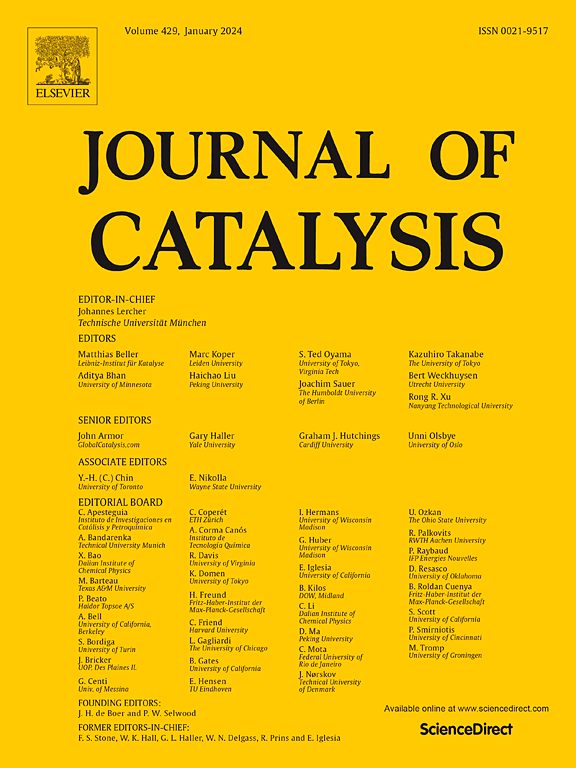用于光催化氧化交叉偶联的远距离离域多氧金属柱型金属有机骨架的设计
IF 6.5
1区 化学
Q2 CHEMISTRY, PHYSICAL
引用次数: 0
摘要
开发一种简单、温和、高效的策略来合成苯并咪唑核心结构及其2-取代衍生物仍然具有挑战性,特别是在环境条件下使用可见光照射而没有外部助催化剂。在本研究中,我们通过水热合成方法将[H2W12O40]6-簇纳入光活性MOF基质中,合成了一种新的多金属氧酸盐基金属有机骨架(POMOF) [Ni(TPT)(H2O)5]{[Ni(TPT)(H2O)3][Ni0.5(H2O)] (H2W12O40)}·TPT·H2O (NiW-TPT)。设计的结构具有战略性地安排电子给体和受体,加上强配体间相互作用,协同促进有效的电子-空穴对分离。值得注意的是,聚金属酸氧酯(POM)簇在催化剂框架内作为“电子海绵”的整合显著抑制了电荷重组。这种独特的结构可以在有氧条件下通过I型光生电子转移途径选择性地产生超氧自由基(O2•-)。优化后的光催化剂表现出优异的性能,在温和的条件下实现了一系列有价值的苯并咪唑衍生物的高收率合成,包括药学上相关的化合物,如哌哌酸和噻苯达唑。值得注意的是,这种方法被证明对缩合反应性杂环醛特别有效。此外,NiW-TPT催化剂在连续5次循环中保持了超过93% %的初始活性,表现出出色的运行稳定性。本文章由计算机程序翻译,如有差异,请以英文原文为准。


Designing a polyoxometalate-pillared metal-organic framework with long-range delocalization for photocatalytic oxidative cross-coupling
The development of a simple, mild and efficient strategy for synthesizing benzimidazole core structures and their 2-substituted derivatives remains challenging, particularly under ambient conditions using visible light irradiation without external cocatalysts. In this study, we synthesized a new polyoxometalate-based metal–organic framework (POMOF) [Ni(TPT)(H2O)5]{[Ni(TPT)(H2O)3][Ni0.5(H2O)] (H2W12O40)}·TPT·H2O (NiW–TPT) by incorporating [H2W12O40]6- clusters into a photoactive MOF matrix through hydrothermal synthesis. The designed architecture features strategically arranged electron donors and acceptors, coupled with strong interligand interactions, which synergistically promote efficient electron-hole pair separation. Notably, the integration of polyoxometalate (POM) clusters as “electron sponges” within the catalyst framework significantly suppresses charge recombination. This unique configuration enables selective generation of superoxide radicals (O2•–) via type I photogenerated electron transfer pathways under aerobic conditions. The optimized photocatalyst demonstrated exceptional performance, achieving high-yield synthesis a range of valuable benzimidazole derivatives under mild conditions, including pharmaceutically relevant compounds such as pipemidic acid and thiabendazole. Remarkably, this method proved particularly effective for condensing reactive heterocyclic aldehydes. Furthermore, the NiW–TPT catalyst maintained over 93 % of its initial activity through five consecutive recycling cycles, demonstrating excellent operational stability.
求助全文
通过发布文献求助,成功后即可免费获取论文全文。
去求助
来源期刊

Journal of Catalysis
工程技术-工程:化工
CiteScore
12.30
自引率
5.50%
发文量
447
审稿时长
31 days
期刊介绍:
The Journal of Catalysis publishes scholarly articles on both heterogeneous and homogeneous catalysis, covering a wide range of chemical transformations. These include various types of catalysis, such as those mediated by photons, plasmons, and electrons. The focus of the studies is to understand the relationship between catalytic function and the underlying chemical properties of surfaces and metal complexes.
The articles in the journal offer innovative concepts and explore the synthesis and kinetics of inorganic solids and homogeneous complexes. Furthermore, they discuss spectroscopic techniques for characterizing catalysts, investigate the interaction of probes and reacting species with catalysts, and employ theoretical methods.
The research presented in the journal should have direct relevance to the field of catalytic processes, addressing either fundamental aspects or applications of catalysis.
 求助内容:
求助内容: 应助结果提醒方式:
应助结果提醒方式:


